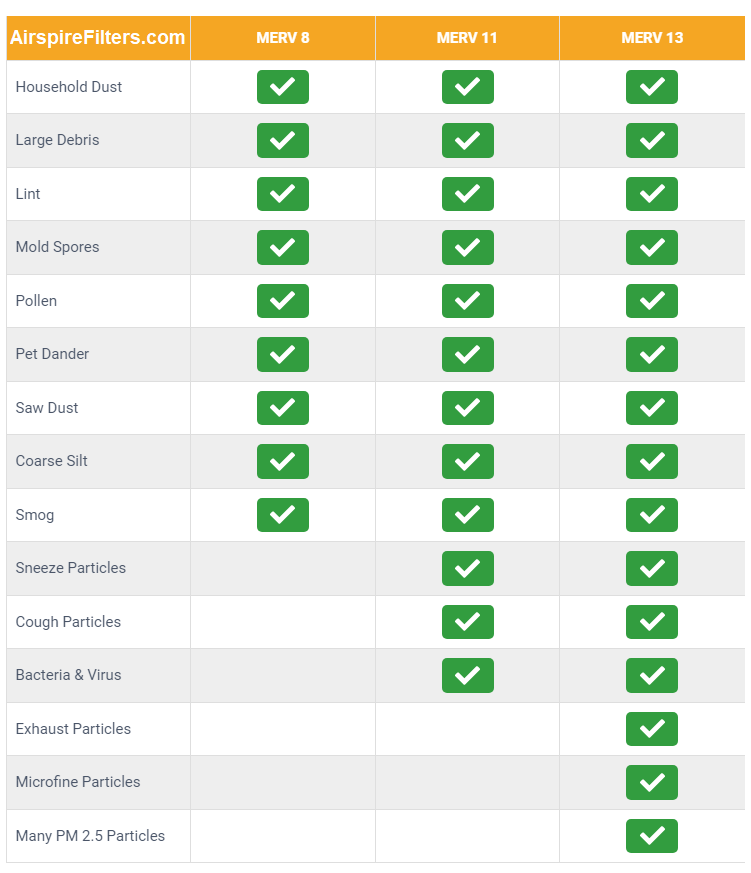MERV Ratings Explained – When it comes to maintaining a healthy home environment, the quality of your indoor air can make a big difference. Air filters are one of the tools used to keep the air clean and free from contaminants. But with so many options available, it can be overwhelming to know which one to choose. One of the most important factors to consider is the MERV rating. In this article, we’ll explain what MERV is and how it can help you breathe easier in your own home. If you’re looking for MERV ratings explained, look no further.
Table of Contents
MERV Ratings Explained
What is MERV and why is it important for air quality?
MERV Ratings Explained – MERV stands for Minimum Efficiency Reporting Value. It’s a rating system that measures the effectiveness of an air filter in removing small particles from the air. This includes dust, pollen, pet dander, and other airborne irritants. The higher the MERV rating, the more efficient the filter is at trapping these particles. A filter with a MERV rating of 1 can capture particles larger than 10 microns, while a filter with a MERV rating of 16 can capture particles as small as 0.3 microns.
Using air filters with high MERV ratings can help improve your indoor air quality by reducing the amount of pollutants in the air. This is especially important for people who suffer from allergies or respiratory issues. A higher-rated filter can also help extend the lifespan of your HVAC system by preventing buildup of dust and debris on the system’s components. However, it’s important to note that higher ratings also mean the filter will need to be changed more frequently as it becomes clogged with pollutants.

Airspire | MERV 8 | MERV 11 | MERV 13 |
Household Dust | |||
Large Debris | |||
Lint | |||
Mold Spores | |||
Pollen | |||
Saw Dust | |||
Pet Dander | |||
Some Smoke | |||
Some Smog | |||
Cough Particles | |||
Sneeze Particles | |||
Bacteria & Some Virus | |||
Many PM 2.5 Particles | |||
Microfine Particles | |||
Exhaust Particles |
What is MERV and why is it important for air quality?
MERV Ratings Explained – MERV stands for Minimum Efficiency Reporting Value. It’s a rating system that measures the effectiveness of an air filter in removing small particles from the air. This includes dust, pollen, pet dander, and other airborne irritants. The higher the MERV rating, the more efficient the filter is at trapping these particles. A filter with a MERV rating of 1 can capture particles larger than 10 microns, while a filter with a MERV rating of 16 can capture particles as small as 0.3 microns.
Using air filters with high MERV ratings can help improve your indoor air quality by reducing the number of pollutants in the air. This is especially important for people who suffer from allergies or respiratory issues. A higher-rated filter can also help extend the lifespan of your HVAC system by preventing buildup of dust and debris on the system’s components. However, it’s important to note that higher ratings also mean the filter will need to be changed more frequently as it becomes clogged with pollutants.
How can you choose the right MERV filter for your home?
MERV Ratings Explained – First off let’s establish that MERV is the only rating system that matters and is the HVAC industry standard. The right MERV filter for your home depends on a few factors, including your HVAC system, your lifestyle, and any health concerns you may have.
Filters with MERV ratings of 1-7 are typically used in residential settings and are good for capturing larger particles. These are often fiberglass filters, are cheaply made and do not remove enough dust in our opinion. This is why we don’t offer any filter under MERV 8.
MERV ratings of 8 is better at trapping smaller particles and are ideal for most households. Our pleated design MERV rated filters are excellent at trapping more particles.
MERV ratings of 9-12 can capture even smaller particles and are beneficial for people with allergies or homes with pets. The ideal size is MERV 11 as there’s really no differences between MERV 11 and 12 filtration wise. There is slight airflow restriction with MERV 12 that you don’t have with MERV 11. This is why we offer MERV 11 versus MERV 12, it’s more universally accepted in HVAC systems.
The difference between MERV 11 and MERV 12 to MERV 13 is substantial. MERV 13 or higher ratings are used in homes with sever allergies, respiratory issues or compromised immune systems. MERV 13 or above are common in commercial or industrial settings. Not all homes HVAC systems can use MERV 13 furnace filters, please check your HVAC systems’ user manual guide or contact us.
MERV Airflow Restriction
MERV Ratings Explained – It’s important to also consider the air flow in your home when selecting a filter. A higher the MERV rating, the more air flow is restricted. Depending on your HVAC system model, this air flow restriction could put additional strain on your HVAC system and cause it to wear sooner.
This is why Airspire only offers filters up to MERV 13, as anything higher can and we believe will damage most HVAC systems. If you’re unsure which MERV rating is right for you, it’s best to consult with a professional HVAC technician or contact us with your furnace or air conditioner make and model numbers. We are happy to help you find the MERV best for your home.
When it comes to maintaining a healthy home, the air you breathe is a critical factor. Choosing the right MERV filter for your needs can help improve your indoor air quality and protect your family from harmful pollutants. Take the time to understand the MERV ratings explained system and consult with a professional to ensure that you’re making the best choice for your home and your health.
By taking a thoughtful approach to selecting air filters, you can go a long way in improving the quality of air in your home. Don’t let allergies, respiratory issues, or other health concerns get in the way of your family’s comfort and wellbeing. With a little bit of research, you can find the right MERV filter to help you breathe easier in your own home.
MERV Ratings Explained – we hope you enjoyed our article about MERV filtration ratings for air filters. You can also visit the EPA webpage about MERV. Should you have any questions, please feel free to contact us. We tried to have MERV ratings explained in this article, how did we do? Tweet at us!
You can also download the MERV rating table above as a shareable image below


